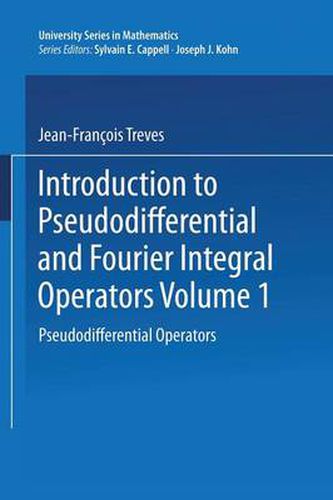Readings Newsletter
Become a Readings Member to make your shopping experience even easier.
Sign in or sign up for free!
You’re not far away from qualifying for FREE standard shipping within Australia
You’ve qualified for FREE standard shipping within Australia
The cart is loading…






This title is printed to order. This book may have been self-published. If so, we cannot guarantee the quality of the content. In the main most books will have gone through the editing process however some may not. We therefore suggest that you be aware of this before ordering this book. If in doubt check either the author or publisher’s details as we are unable to accept any returns unless they are faulty. Please contact us if you have any questions.
I have tried in this book to describe those aspects of pseudodifferential and Fourier integral operator theory whose usefulness seems proven and which, from the viewpoint of organization and presentability, appear to have stabilized. Since, in my opinion, the main justification for studying these operators is pragmatic, much attention has been paid to explaining their handling and to giving examples of their use. Thus the theoretical chapters usually begin with a section in which the construction of special solutions of linear partial differential equations is carried out, constructions from which the subsequent theory has emerged and which continue to motivate it: parametrices of elliptic equations in Chapter I (introducing pseudodifferen tial operators of type 1, 0, which here are called standard), of hypoelliptic equations in Chapter IV (devoted to pseudodifferential operators of type p, 8), fundamental solutions of strongly hyperbolic Cauchy problems in Chap ter VI (which introduces, from a naive standpoint, Fourier integral operators), and of certain nonhyperbolic forward Cauchy problems in Chapter X (Fourier integral operators with complex phase). Several chapters-II, III, IX, XI, and XII-are devoted entirely to applications. Chapter II provides all the facts about pseudodifferential operators needed in the proof of the Atiyah-Singer index theorem, then goes on to present part of the results of A. Calderon on uniqueness in the Cauchy problem, and ends with a new proof (due to J. J. Kohn) of the celebrated sum-of-squares theorem of L. Hormander, a proof that beautifully demon strates the advantages of using pseudodifferential operators.
$9.00 standard shipping within Australia
FREE standard shipping within Australia for orders over $100.00
Express & International shipping calculated at checkout
This title is printed to order. This book may have been self-published. If so, we cannot guarantee the quality of the content. In the main most books will have gone through the editing process however some may not. We therefore suggest that you be aware of this before ordering this book. If in doubt check either the author or publisher’s details as we are unable to accept any returns unless they are faulty. Please contact us if you have any questions.
I have tried in this book to describe those aspects of pseudodifferential and Fourier integral operator theory whose usefulness seems proven and which, from the viewpoint of organization and presentability, appear to have stabilized. Since, in my opinion, the main justification for studying these operators is pragmatic, much attention has been paid to explaining their handling and to giving examples of their use. Thus the theoretical chapters usually begin with a section in which the construction of special solutions of linear partial differential equations is carried out, constructions from which the subsequent theory has emerged and which continue to motivate it: parametrices of elliptic equations in Chapter I (introducing pseudodifferen tial operators of type 1, 0, which here are called standard), of hypoelliptic equations in Chapter IV (devoted to pseudodifferential operators of type p, 8), fundamental solutions of strongly hyperbolic Cauchy problems in Chap ter VI (which introduces, from a naive standpoint, Fourier integral operators), and of certain nonhyperbolic forward Cauchy problems in Chapter X (Fourier integral operators with complex phase). Several chapters-II, III, IX, XI, and XII-are devoted entirely to applications. Chapter II provides all the facts about pseudodifferential operators needed in the proof of the Atiyah-Singer index theorem, then goes on to present part of the results of A. Calderon on uniqueness in the Cauchy problem, and ends with a new proof (due to J. J. Kohn) of the celebrated sum-of-squares theorem of L. Hormander, a proof that beautifully demon strates the advantages of using pseudodifferential operators.